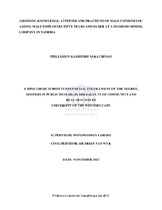| dc.description.abstract | Background: The HIV / AIDS pandemic have been characterized as the greatest natural challenge ever to confront humanity and one of the great moral causes of our time (World Bank, 2007). Although, the HIV and AIDS pandemic is a global problem, some regions of the world, notably sub-Saharan Africa are hardly hit by the pandemic. Namibia is one of the sub-Saharan African countries which are badly affected by the HIV and AIDS pandemic. It is estimated that about 360 000 Namibians were infected with HIV by 2010. This translates to a national HIV prevalence of (18.8%). The National HIV and AIDS Response Department has designed various interventions and strategies to curb the spread of the HIV. Promotion of male condoms promotion is one of the key strategies being advocated. If used consistently and correctly, male condoms are regarded as an effective preventive tool of HIV transmission. However, changing individual’s sexual behaviors and lifestyle to make condom use part of their sexual life seems to be the challenge. In Namibia most of the research in the area of HIV and AIDS were done among the youth and population aged between 15 – 49 years. Hence, this study looks at older men as a neglected population. Aim: The aim of the current study was to assess knowledge, attitudes and practices of condom use among male employees age 50 (fifty) years and older at a mining company in Southern Namibia. Methodology: A descriptive, cross-sectional survey utilizing quantitative research approach was applied. Data was collected through face-to-face interviewing male employees, age fifty years and older, while at work at the Mine Area 1 (MA1). Data was captured in excel and imported into SPSS version 16.0. Chi-square test was used to determine the association between KAP variables and the socio-demographic characteristics of the respondents. The level of statistical significance was set at 0.05. Results: Among 105 respondents (males, mean age 54.5 years), more than half lived in the singe sex male hostels. Knowledge about condom use was good but there remained a significant number of the respondents whose knowledge was insufficient. A high percentage of the respondents suggested that HIV positive individuals should always use condom every time they have sexual intercourse. Conclusion: This study showed that respondents are not at a high risk of contracting HIV infection due to lack of knowledge on condom use though some of them possessed insufficient knowledge. Thus, to minimize the likelihood of HIV infection targeted interventions including peer education programmes were suggested, and working with the community in the area. Moreover, a more comprehensive knowledge attitude and practice study among mine employees from various sections of the mine would be beneficial to identify the level of risk within the total employee population. | en_US |

